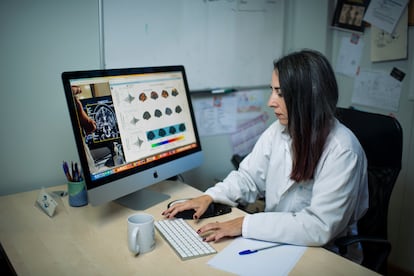Susana Carmona, neuroscientist: ‘We know more about the universe than women’s brains’
The Spanish researcher studies the neuroplasticity of women’s nervous system during pregnancy

Motherhood is an event that changes women’s lives, but also affects their brains — and probably for life. Susana Carmona knows this very well, since she and her team at the Gregorio Marañón University Hospital (HGUGM) published the first study on the brain’s neuroplasticity during pregnancy eight years ago. Among other things, they discovered that the gray matter of pregnant women is reduced in the months before and after childbirth, although the reasons why these changes occur and for what purpose remain a mystery that needs to be researched in depth. “The farther we advance, the more we know about women’s brains, but this gives rise to more and more questions,” she acknowledges. Carmona, a doctor in neuroscience, leads the HGUGM Neuroimaging Group and has just published a new study on the matter.
Q. Why do pregnant women’s brains change?
A. The question is, how is the brain not going to change? A woman’s entire body changes during pregnancy. Her cardiovascular system, her renal system, her feet are going to grow, her skin color, they all change. It happens because all the organs have to adapt to gestate. The difference is that, in some cases, we know the specific function of why it adapts, and in others we do not. But what seems strange to me is that no one had ever asked what happens in the brain when a woman’s entire body changes.
Q. Why do you think no one asked this question?
A. There is a significant gender bias in biomedicine, not only when we talk about pregnancy. Menopause is another great unknown, likewise the effects of hormonal treatments. There are many young women who are taking contraceptives today, and there are still not enough studies to know what happens in the brain. We know more about the universe than about women’s brains.
Q. What exactly did you discover with your first study?
A. The first thing that was discovered, and the reason why it had such an impact, is that a woman’s brain changes profoundly with pregnancy. And when I say profoundly, I mean that I have been doing studies with different mental pathologies and analyzing brains for many years, and I have never seen changes as powerful, as marked, and consistent as those that occur during pregnancy and motherhood. We saw that a woman’s brain changes and that the more it changes, the better the bond with the baby. That posed many more questions, which is what we are now researching.
Q. Can you give an example?
A. People want to know what happens to fathers, if they also change like mothers. Or if these changes are similar to those that occur during adolescence. Since then we have not stopped searching for the answers to all these questions. In 2019 we published another study in which we compared the anatomical changes that occur in a woman’s brain during pregnancy with those that occur in girls when they go through puberty, and we verified that at the level of shape and magnitude, these changes are very similar. In both processes there is a decrease in gray matter.
Q. Put that way it seems like something bad.
A. Now, when you say that a woman’s brain reduces in volume, everyone automatically thinks of degeneration, of atrophy. But in biology less is not always worse. To study these changes we use magnetic resonance imaging, which allows us to find out what is happening at the brain level. For now, we have not observed any associations with cognitive changes, in what may be the way of executing tasks during and after pregnancy. If we look at animal models, where there are more studies with mice, we see how neurons are more connected in some regions, while in others they are less connected.
Q. What does this mean exactly?
A. Right now we are not very clear about our hypothesis. At first, since we saw changes similar to adolescence, we thought it was due to a mechanism similar to synaptic pruning [the process by which most of the unnecessary connections formed in the first years of life are eliminated]. Now we are not so clear, because the changes are very dynamic. What we see is that some changes persist and others do not. This is telling us that the cells that are behind these changes have to be very dynamic. And we know that during pregnancy, the mother’s entire immune system has to be hacked in order to tolerate a being growing inside her that is genetically different from her. That could be the explanation, but right now it is a hypothesis that we are investigating.
Q. Is it possible that the change has the function of preparing the woman to care for her baby?
A. This is what we want to discover, but to affirm it now would be philosophizing. A study that we are working on with the team at the Autonomous University of Barcelona will soon be published, and it may give us certain clues, but I cannot give too much information yet. What I can say is that it is not a direct relationship. It is not the brain that changes to prepare for caregiving, which is often what is misinterpreted in the results. It is the way it has changed that makes the mother care, and the fact that she cares has helped the species survive as it is.
Q. In the latest published study, differences were found that were dependent on the type of delivery.
A. This study was not specifically aimed at investigating the type of birth, but it has allowed us to obtain useful information in this regard. We had 12 women with a scheduled cesarean section, 11 with an emergency cesarean section, and about 80 with a vaginal birth. The comparisons are still preliminary, [and it’s too early] to be able to give accurate answers, but by comparing the types of births we have seen that there is no difference between emergency cesarean section and vaginal birth. The difference is between the scheduled cesarean section and the rest. It is because the hormonal environment that exists during childbirth, when contractions begin, has nothing to do with what happens during pregnancy or the postpartum period. It is a unique situation that if it is not experienced, as in the case of women who have a scheduled cesarean section, causes the brain to change differently.
Q. Does it change for the better or for the worse?
A. It is too early to say, and very dangerous too, because it is not ready to be put into clinical practice. It is something that we discovered throughout this study and that we have to explore in depth by controlling all the possible variables. We have hypotheses as to why this happens, such as that childbirth itself produces specific neuropathic effects.
Q. One thing we do know for sure is that the more the brain changes, the stronger the bond between mother and baby. How do you measure that?
A. It’s very complicated. The only way we have is to do neuroimaging studies and follow up with questionnaires. These are questions that measure whether mothers develop hostility towards the baby, how much pleasure they feel when interacting with it. The scales are validated and will give us a score. What we saw in the first study is that brain changes predicted bonding after childbirth. I do not believe that this association is direct, it must be mediated by other factors, and it is not absolute either. It’s not that if my brain doesn’t change during pregnancy I won’t have a bond with my baby. Now, how do we go from brain, anatomy, brain to bond? Well, all these questions about whether there are hormonal factors that mediate them, immune factors, inflammatory factors, well-being, depression, anxiety, all of this is what we have to finish researching.
Q. Can we talk about maternal instinct in neurobiology?
A. It is very complicated for scientists to give names to things. When you start looking for definitions of instinct, in every possible dictionary, there are subtleties that can make the answer yes or no. For me, it’s yes. We can talk about maternal instinct, but with my mental definition of what maternal instinct is, which is not the desire to be a mother, or that suddenly you give birth and know what you have to do with the baby. For me, the maternal instinct is a motivation to be in contact with the baby. Not even enjoying contact with them, but worrying and being in contact with them to find out what’s going on. Furthermore, if this instinct did not exist, we would have become extinct. Without the motivation to care for a thing that screams and often bothers us, the human being as such would no longer exist.
Q. How long do these changes in women's brains last?
A. We don’t know, but we have indications from other studies that they can be lifelong. We have investigated what happens up to six years postpartum and changes are still seen. But there are other researchers who take large databases, which have tens of thousands of participants, and compare those who are mothers with those who are not. There are even women who are in their seventies in whom specific changes persist. It is also impossible to say exactly if biology is behind these changes or if the environment also influences them. It may depend on the type of upbringing they had, or their lifestyle. There are also studies that associate these changes with the hormonal levels of estrogen to which women are subjected during the nine months of pregnancy, and that in the long term could affect how the woman faces menopause and how she transitions to adulthood.

Q. And what happens with the following pregnancies?
A. This is what we are researching now, along with possible changes in the brains of parents. But a lot of data is needed to draw conclusions. It is work that takes time.
Q. Is it difficult to find participants?
A. It is very difficult, especially depending on the approach of the study. We need to monitor women before they become pregnant and then during the early postpartum period. You have to do a lot of MRIs, but not all of them are going to be useful because many women who start the study are not going to get pregnant. Others may lose the baby, or simply lose interest because there is a follow-up that lasts many months. It is also economically very expensive. Researchers have to be very motivated to want to invest their time in projects that take much longer than science in Spain allows.
Q. In addition to researching a topic about which very little is known, what is this knowledge useful for?
A. Several things. If we take it to the clinical field, the first thing that comes to everyone’s mind is postpartum mental pathology. Today we are trying to predict, treat, and cure postpartum mental pathologies, and we do not even know exactly what happens in a woman’s brain during pregnancy. So, one of the most direct applications would be to try to develop treatments aimed at perinatal pathologies. Understanding how this may affect menopause, or how it may affect women who are at higher risk of developing Alzheimer’s disease, is also important.
Sign up for our weekly newsletter to get more English-language news coverage from EL PAÍS USA Edition
Tu suscripción se está usando en otro dispositivo
¿Quieres añadir otro usuario a tu suscripción?
Si continúas leyendo en este dispositivo, no se podrá leer en el otro.
FlechaTu suscripción se está usando en otro dispositivo y solo puedes acceder a EL PAÍS desde un dispositivo a la vez.
Si quieres compartir tu cuenta, cambia tu suscripción a la modalidad Premium, así podrás añadir otro usuario. Cada uno accederá con su propia cuenta de email, lo que os permitirá personalizar vuestra experiencia en EL PAÍS.
¿Tienes una suscripción de empresa? Accede aquí para contratar más cuentas.
En el caso de no saber quién está usando tu cuenta, te recomendamos cambiar tu contraseña aquí.
Si decides continuar compartiendo tu cuenta, este mensaje se mostrará en tu dispositivo y en el de la otra persona que está usando tu cuenta de forma indefinida, afectando a tu experiencia de lectura. Puedes consultar aquí los términos y condiciones de la suscripción digital.











































